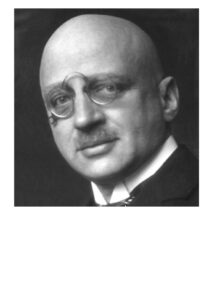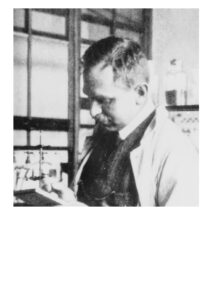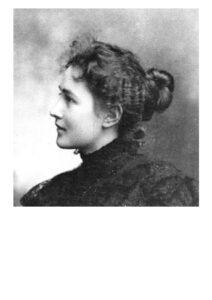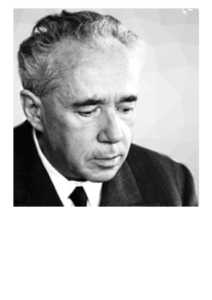A Chemistry Picture Quiz about Cooperation Partners
Collaborations are incredibly beneficial in many careers, including science, as they allow individuals to share knowledge and resources, which can lead to discoveries and innovations. Many famous scientists have collaborated throughout history and collaboration has been a key driver of scientific progress.
Each picture below shows a famous chemist. Did the ones next to each other also work together scientifically?


Did they work together?
Image on the left: © BASF; BASF-Negativnummer 12508-alt
See answer
No
The Haber-Bosch process is a chemical process for synthesizing ammonia from nitrogen gas and hydrogen gas, which was developed by the German chemists Fritz Haber (pictured right; 1868 – 1934) and Carl Bosch (1874 – 1940). The Haber-Bosch process made it possible for the first time to produce synthetic fertilizers and produce sufficient food for the Earth’s growing population.
Fritz Haber and his assistant Le Rossignol created the necessary equipment and materials to perform the Haber process on a small scale in the laboratory. Later on, the German company BASF bought the process and tasked Carl Bosch with making it work on an industrial scale. Bosch succeeded in 1910.
Both, Haber and Bosch received Nobel prizes for their work in solving the chemical and engineering challenges of large-scale, continuous-flow, high-pressure technology. Haber won his prize in 1918 and Bosch in 1931.
Sources
[1] 75th Anniversary: Carl Bosch’s Death, ChemistryViews 2015.
[2] Vera Koester, Stamp for the 150th Birthday of Carl Bosch, ChemistryViews 2024. https://doi.org/10.1002/chemv.202400087
[3] 80th Anniversary of Fritz Haber’s Death, ChemistryViews 2014.


Did they work together?
See answer
Yes
Lise Meitner (1878 – 1968) and Otto Hahn (1879 – 1968) were collaborators in the field of nuclear physics, and they are best known for their work on nuclear fission. Meitner provided the theoretical interpretation of the experimental results, while Hahn conducted the experiments.
Lise Meitner was not initially given proper credit for her contributions to the discovery of nuclear fission. Otto Hahn received the Nobel Prize for Chemistry in 1944 without Lise Meitner, leading many to speculate that this was due to gender discrimination and the fact that Lise Meitner had fled Nazi Germany for Sweden at the time of the award. Lise Meitner’s contributions have since been acknowledged, and she is today regarded as one of the most important physicists of the 20th century.
Sources
[1] Catharina Goedecke, 50th Anniversary: Death of Lise Meitner, ChemistryViews 2018. https://doi.org/10.1002/chemv.201800099
[2] 50th Anniversary: Death of Otto Hahn, ChemistryViews 2018.


Did they work together?
See answer
Yes
The Michaelis-Menten equation is a mathematical model used in enzyme kinetics to describe the relationship between enzyme activity and substrate concentration. It was developed by German biochemist Leonor Michaelis (1875 – 1949) and Canadian medical scientist Maud Menten (1879 – 1960).
Since women were not allowed to participate in research in Canada at the time, Maud Menten looked in other countries to continue her work. In 1912, she moved to Berlin, Germany, where she worked with Leonor Michaelis.


Did they work together?
Images courtesy of Alexander Rich
See answer
Yes
Francis Harry Compton Crick (1916 – 2004; pictured left) and James Dewey Watson (1928) discovered the structure of DNA. They cooperated by working together at the Cavendish Laboratory in Cambridge, UK, and using X-ray crystallography data from Rosalind Franklin and Maurice Wilkins to develop a model of the DNA molecule as a double helix.
Their discovery was a breakthrough in the field of molecular biology and laid the foundation for understanding genetic information and its transmission.
Source
[1] Klaus Roth, Deciphering the Genetic Code: The Most Beautiful False Theory in Biochemistry, ChemistryViews 2021. https://doi.org/10.1002/chemv.202100072


Did they work together?
See answer
Yes.
Irène Joliot-Curie (1897 – 1956; pictured right) and Marie Salomea Skłodowska–Curie (1867 – 1934) were mother and daughter scientists who made significant contributions to the field of radioactivity. They worked together in their laboratory in Paris, France, and developed methods for isolating radioactive isotopes, which they used in medical treatments for cancer.
In 1935, Irène and her husband Frédéric Joliot-Curie were awarded the Nobel Prize in Chemistry for their work in radioactivity, following in the footsteps of Marie Curie, who was the first woman to win a Nobel Prize and the first person and the only woman to win a Nobel Prize twice; Nobel Prize in Physics in 1903 and Nobel Prize in Chemistry in 1911.
Marie Curie’s husband, Pierre Curie, was a co-winner of her first Nobel Prize. This achievement made them the first married couple to win the Nobel Prize. It also paved the way for the Curie family’s ongoing success, with a total of five Nobel Prizes awarded to family members over time.
Source
[1] Website of the Nobel Foundation, Stockholm, Sweden


Did they work together?
See answer
See answer
No
Kenichi Fukui (pictured left) and Roald Hoffmann (pictured right) jointly received the 1981 Nobel Prize in Chemistry “for their theories, developed independently, concerning the course of chemical reactions”. Fukui was the first person of East Asian descent to be awarded a Nobel Prize in Chemistry.
Fukui’s prize-winning work focused on the role of frontier orbitals in chemical reactions. Specifically he found that molecules share loosely bond electrons that occupy the frontier orbitals, that is, the Highest Occupied Molecular Orbital (HOMO) and the Lowest Unoccupied Molecular Orbital (LUMO) [1].
Together with Robert Burns Woodward, Roald Hoffmann developed the Woodward-Hoffmann rules for explaining reaction mechanisms and their stereochemistry. They realized that chemical transformations could be approximately predicted from subtle symmetries and asymmetries in the electron orbitals of complex molecules [2].
References
[1] Catharina Goedecke, Kenichi Fukui and the Importance of Frontier Orbitals, ChemistryViews 2023. https://doi.org/10.1002/chemv.202300073
[2] Jeffrey I. Seeman, Stories and Stories-Behind-the Stories of the Woodward-Hoffmann Rules, ChemistryViews 2022. https://doi.org/10.1002/chemv.202200013


Did they work together?
See answer
No
The Nobel Prize in Chemistry 1963 was awarded jointly to Karl Ziegler (1898–1973) and Giulio Natta (1903–1979; pictured left) “for their discoveries in the field of the chemistry and technology of high polymers.” [1]
In 1953, Karl Ziegler discovered that polyethylene could be produced at low pressures via a catalytic route using a mixture of TiCl4 and triethyl aluminum. Giulio Natta was convinced that this catalyst was key for the regular polymerization of other unsaturated compounds and developed the work further with financial aid from the Italian chemical company Montecatini.
Natta extended Ziegler’s research to achieve stereospecific polymerizations of propene. He discovered new classes of polymers with a sterically ordered structure (stereoregularity), such as isotactic and syndiotactic polymers.
References
[1] Catharina Goedecke, 120th Birthday: Giulio Natta, ChemistryViews 2023. https://doi.org/10.1002/chemv.202300010
Also of Interest

Quiz about famous chemist couples

Starting from the early alchemists we take a journey through time to examine how each of these chemists pushed the boundaries of what is possible


